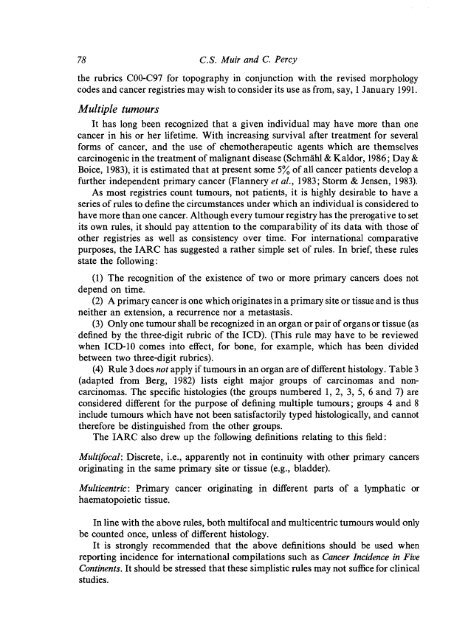Cancer Registration: Principles and Methods - IARC
Cancer Registration: Principles and Methods - IARC
Cancer Registration: Principles and Methods - IARC
You also want an ePaper? Increase the reach of your titles
YUMPU automatically turns print PDFs into web optimized ePapers that Google loves.
78 C.S. Muir <strong>and</strong> C. Percy<br />
the rubrics COO-C97 for topography in conjunction with the revised morphology<br />
codes <strong>and</strong> cancer registries may wish to consider its use as from, say, 1 January 1991.<br />
Multiple turnours<br />
It has long been recognized that a given individual may have more than one<br />
cancer in his or her lifetime. With increasing survival after treatment for several<br />
forms of cancer, <strong>and</strong> the use of chemotherapeutic agents which are themselves<br />
carcinogenic in the treatment of malignant disease (Schmahl & Kaldor, 1986; Day &<br />
Boice, 1983), it is estimated that at present some 5% of all cancer patients develop a<br />
further independent primary cancer (Flannery et al., 1983; Storm & Jensen, 1983).<br />
As most registries count tumours, not patients, it is highly desirable to have a<br />
series of rules to define the circumstances under which an individual is considered to<br />
have more than one cancer. Although every tumour registry has the prerogative to set<br />
its own rules, it should pay attention to the comparability of its data with those of<br />
other registries as well as consistency over time. For international comparative<br />
purposes, the <strong>IARC</strong> has suggested a rather simple set of rules. In brief, these rules<br />
state the following :<br />
(1) The recognition of the existence of two or more primary cancers does not<br />
depend on time.<br />
(2) A primary cancer is one which originates in a primary site or tissue <strong>and</strong> is thus<br />
neither an extension, a recurrence nor a metastasis.<br />
(3) Only one tumour shall be recognized in an organ or pair of organs or tissue (as<br />
defined by the three-digit rubric of the ICD). (This rule may have to be reviewed<br />
when ICD-10 comes into effect, for bone, for example, which has been divided<br />
between two three-digit rubrics).<br />
(4) Rule 3 does not apply if tumours in an organ are of different histology. Table 3<br />
(adapted from Berg, 1982) lists eight major groups of carcinomas <strong>and</strong> noncarcinomas.<br />
The specific histologies (the groups numbered 1, 2, 3, 5, 6 <strong>and</strong> 7) are<br />
considered different for the purpose of defining multiple tumours; groups 4 <strong>and</strong> 8<br />
include tumours which have not been satisfactorily typed histologically, <strong>and</strong> cannot<br />
therefore be distinguished from the other groups.<br />
The <strong>IARC</strong> also drew up the following definitions relating to this field:<br />
Multifocal: Discrete, i.e., apparently not in continuity with other primary cancers<br />
originating in the same primary site or tissue (e.g., bladder).<br />
Multicentric: Primary cancer originating in different parts of a lymphatic or<br />
haematopoietic tissue.<br />
In line with the above rules, both multifocal <strong>and</strong> multicentric tumours would only<br />
be counted once, unless of different histology.<br />
It is strongly recommended that the above definitions should be used when<br />
reporting incidence for international compilations such as <strong>Cancer</strong> Incidence in Five<br />
Continents. It should be stressed that these simplistic rules may not suffice for clinical<br />
studies.
















